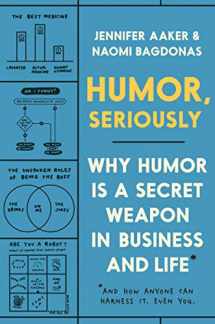
Humor, Seriously: Why Humor Is a Secret Weapon in Business and Life (And how anyone can harness it. Even you.)
Book details
Summary
Description
Chapter 1
The Humor Cliff
“Humor is mankind’s greatest blessing.”—Mark Twain
It’s the first day of spring quarter at Stanford’s Graduate School of Business. Fifty students excitedly file into a lecture hall, a few still wondering whether the course they’ve registered for is an elaborate joke played by the administration. “Humor: Serious Business” is about to begin.
Whiteboards line the walls; all the chairs and tables have wheels, for easy rearranging. It’s a setting that’s ideal for workshopping and terrible for napping. Jennifer, in her self-appointed role as DJ, has David Bowie’s “Rebel Rebel” blasting. Naomi has a clip from SNL cued up to kick off the lecture.
And yet trepidation hangs heavy in the air.
Before class begins each semester, we have our students complete a “Humor Audit,” a self-reflection exercise / terrifyingly personal quiz about how they use humor in their lives. It includes questions like “Who or what makes you laugh the most in your life?” and “Who do you feel the funniest around?” and “Please submit complete documentation of your income, expenses, and assets for the previous fiscal year.”
So it’s understandable that the students feel spooked: A sense of humor is like a muscle—it atrophies without regular use. Unfortunately, we find that in most students and executives we start working with, atrophy abounds. Just look at these responses to the question “When was the last time you really laughed?”:
“I honestly can’t remember. Is that terrible?”
“I’ve been thinking and am drawing a blank! I know I laugh. Or at least I thought I did, which now I’m questioning . . .”
“On Tuesday, I did not laugh once. Not once. Who knew a class about humor could be so depressing?”
The good and bad news about these responses is that our students are not alone. And it’s not Tuesday.
The Humor Cliff
The collective loss of our sense of humor is a serious problem afflicting people and organizations globally. We’re all going over the humor cliff together, tumbling down into the abyss of solemnity below.
At the bottom of that abyss we’re joined by the majority of 1.4 million survey respondents in 166 countries who revealed in this Gallup poll that the frequency with which we laugh or smile each day starts to plummet around age twenty-three.
To some extent, this pattern makes sense. As kids, we laugh all the time. The average four-year-old laughs as many as three hundred times per day. (The average forty-year-old, by comparison, laughs three hundred times every two and a half months.) Then we grow up, enter the workforce, and suddenly become “serious and important people,” trading laughter for ties and pantsuits.
Before long, we lose levity entirely in a sea of bottom lines, slide decks, and mind-numbing conference calls. Our sense of play is repressed by a dizzyingly complex and dynamic professional environment, full of social land mines that are difficult to gauge and feel safer to avoid. As a result, most of us choose to keep our interactions sterile, measured, and professional; we go to work each day and leave our sense of humor—and so much more of ourselves—at the door.
This response signals a fundamental misunderstanding about how to work—how to solve important problems, how to conduct ourselves, and how to be successful.
We don’t need more “professionalism” in our workplaces. Instead, we need more of ourselves, and more human connection—especially as in-person meetings are replaced by video chats and more relationships are sustained entirely by email. Often, all it takes is a hint of levity to shift a moment, or a relationship, from transactional and robotic to relational and authentic.
So what’s holding us back?
Our research reveals four common misperceptions—or, as we like to call them:
The Four Deadly Humor Myths
After we surveyed more than seven hundred people across a wide range of industries and levels about what holds them back from using humor at work, four themes emerged, each rooted in a myth th


We would LOVE it if you could help us and other readers by reviewing the book
Book review



